WARGAMESOSD Storm Over Scandinavia - Operation Icarus (1) |
A
Grand Europa Battle Scenario by Arthur Goodwin Icarus - The Battle for Iceland July - October 1940 | |
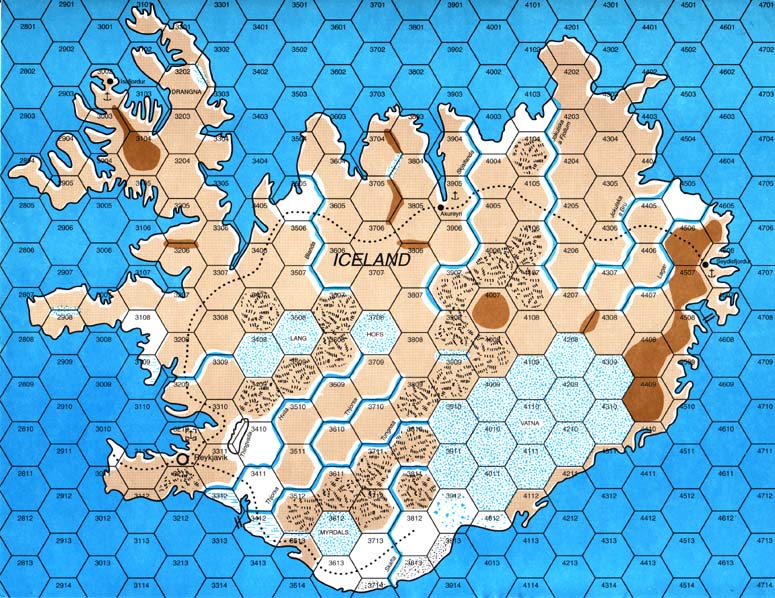 The supplementary Iceland map issued with Europa Magazine # 65 | |
Introduction 'Operation Icarus' is a scenario for Storm Over Scandinavia covering a hypothetical German invasion of Iceland in the summer of 1940. The battles for Norway and France have just ended in Allied defeat. While the British are reeling from the disastrous losses at Dunkirk and girding for an expected invasion of Britain itself, Germany has decided to make a grab for Iceland as well. Establishment of Axis air and naval facilities on the island would allow for potentially crippling attacks on England's vital convoy routes across the North Atlantic. Will the German plan succeed? Or will Iceland be where Britain first stems the German tide of conquest? Background Germany had contemplated a jump into Iceland to take place shortly after Norway was occupied. This plan was codenamed 'Operation Icarus'. (The codename refers to one half of a pair of mythical heroes (the other was his father Daedaelus) who escaped imprisonment by the gods by fashioning wings from feathers and wax; but Icarus ventured too close to the sun and plunged to his death as a result.) The heavy losses suffered by the Kriegsmarine during the Norwegian campaign, the loss of most of the staff of the designated lead division for this operation (the 163rd) when the cruiser Blucherwas sunk in the Oslofjord, and the longer-than-expected Allied resistance in northern Norway,, all delayed implementation of the plan and allowed Britain to reach Iceland first. German preoccupation with the Battle of Britain and the decided lack of enthusiasm for this project exhibited by the Kriegsmarine command, finally resulted in the operation's cancellation in late 1940. This scenario, however, postulates that Germany decides to continue with the operation, gambling that a surprise descent can be pulled off once again and that German aerial might will be sufficient to supply, reinforce, and support the attacking force even in the face of overwhelming British naval superiority. Components To play this scenario you will need the Iceland map, 'Operation Icarus' Off-Map Holding Boxes and Distance Display, and Axis and Allied OBs in this magazine; various charts and counters and the Scenario Rules (including the 18 January 1999 errata) from the Storm Over Scandinavia game; and the following additional British counters. | |
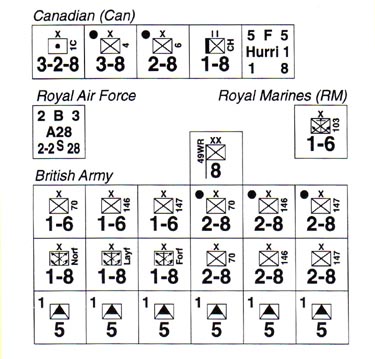 Plain version | 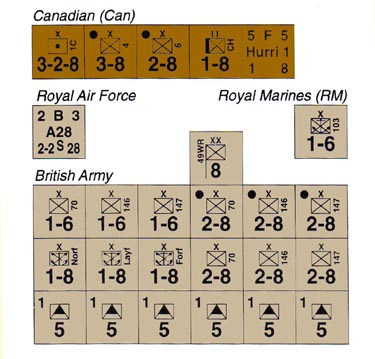 Europa colours added |
Note:
Counters for the position AA and Marine Commando units can be found in the game
Second Front. Counters for the other units will have to be manufactured. (Although
all of these counters will probably appear in the upcoming game Lightning War.) | |
| Preparing
for Play The Axis player is the first player and the Allied player is the second. The scenario starts with the Jul 140 game turn and ends upon the completion of the Oct II 40 game turn. Starting
Conditions. Use the Iceland map and 'Operation Icarus' Off-Map Holding Boxes and
Distance Display Chart provided in this magazine. Use the Jul 140 initial forces
and reinforcements from the'Operation Icarus' Axis and Allied OBs in this magazine.
Units may deploy broken down. Supply
(Rule 12). Any major port in Norway is a regula supply source for Axis units.
Due to Allied navy superiority, the Axis player may not trace a naval elemer supply
line through any sea hex on the Iceland ma unless: 1) The Faeroe Islands off-map
holding box is Axis owned, and 2) at least one Axis naval TF unit is on-map. player
may not trace a naval element supply line from the Faeroe Islands or South Greenland
off-map holding box the box in question is blockaded. A holding box blockaded
if an enemy naval TF unit is present in the box | |
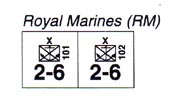 Plain version | 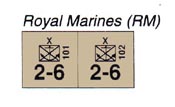 Europa colours added |
| American
Intervention. The United States had a contingency plan to move into Iceland
in response to a German occupation of the island. It's doubtful if this would
have taken place in 1940, however, as American isolationism was still strong and
the US Congress was still actively fighting Roosevelt's efforts to enter the war.
If you want an optional rule to cover this, however, roll for possible US entry
when Axis ground units first enter Iceland. On a roll of 6 the US intervenes and
the Iceland Contingency Force appears as specified in the conditional reinforcements
section of the Allied OB. On any other roll, the US remains neutral. If the US
intervenes, double the VP awards at the end of the scenario for Axis ownership
of ports. This option requires the use of the following counters (all of which can be found in the game Second Front): | |
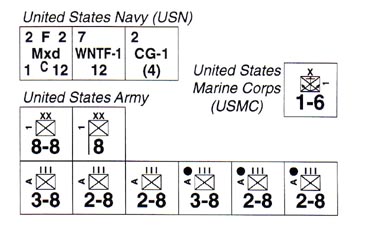 Plain version | 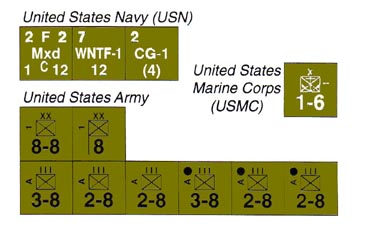 Europa colours added |
| Increased
Axis Commitment. Germany had additional forces that could have been committed
to a campaign for Iceland. Some typical forces that would have been available
are listed in the conditional reinforcements section of the Axis OB. If this option
is used, the Axis player may receive any or all of these forces as reinforcements
during any of his initial phases. Place such reinforcements in any Norway holding
boxes. Award the Allied player 2 VPs for each additional German ground unit and
4 VPs for each additional German air unit committed to the campaign. Other. Players are encouraged to use the following optional rules from Storm Over Scandinavia: Supply Point Expenditure (44B3), Airbase Supply (44C1) and Air Drop Capacity (44C2).
| |
| 'Operation
Icarus' Designer's Notes I first learned of Operation Icarus almost two decades ago from a footnote in Ziemke's book Northern Theater of Operations, and was immediately grabbed by the sheer audacity of the plan. When a trip to the library revealed that Iceland is generally considered part of Europe, I resolved that this operation had to be gamed at Europa scale, somehow. Well, it took 15 years, but I finally managed to convince GRID to do it. Uncovering the wherewithal of the German contingency plan was a frustratingly slow process. Bits and pieces of the plan popped up in a host of American, British, and German general sources over the years. But, until the publication of Tarnstrom's The Sword of Scandinavia, in 1996, I had no overall description of the plan. Although Tarnstrom provides only the bare bones of the planned operation, his description matches perfectly with the other pieces I'd already uncovered, and was enough to put together a playable scenario. Initially, Icarus was two distinct scenarios: the one in this magazine and a second scenario starting in March, 1941 based on British fears of a major German airdrop onto Iceland. OB research and playtest experience showed the second scenario was not viable, however. No matter how much the Brits agonized over German ability to air assault the island in 1941, by that date England had sufficient naval, air, and ground assets not being used anywhere else to swiftly shut down any German invasion. Also, historical accounts make it clear that a German invasion in 1941 would almost certainly have resulted in an early war with the United States. A German invasion of Iceland in 1940 is another matter, however. America is much more isolationist, and Britain is desperately short of everything as they concentrate on the Battle of Britain. Playtest has shown that this scenario is a challenge for both sides. The scenario assumes a mostly historical campaign for Norway, but that Germany retains in Norway various forces (mostly air units) that historically transferred to the West for the Battle of Britain. Three items in the German OB may not immediately be obvious: #1) The OB lists the 3rd Mountain XX as one of the lead assault units. In reality, the 2nd XX probably would have been used instead (as the 3rd was cadred during the battle for Narvik and would have been rebuilding during the summer of 1940), with the 2nd stripped-down for naval transport in the same manner the 3rd was for the Narvik operation. As there is no 'stripped-down' 2nd XX counter, I went with the 3rd so as to cut down on the number of counters players are required to make. #2) Both of the German DD TF naval units incurred losses in the campaign for Norway (reducing one to 1 pt and the other to 2 pts). I brought both these units back to full strength by reassigning to them every German light ship (CL, DD, TB) still afloat. #3) The 'Increased Axis Commitment' forces represent rebuilding and committing to Iceland the cadred mountain XX at Narvik, calling up some of the German air training schools to get additional air transport assets, and amalgamating various squadrons of day and night Ju 88C2s in order to scrape up another group of long-range fighters. The Allied OB assumes commitment to Iceland of the historical British force, augmented by a strong Canadian reaction force (as Canada would assuredly be strongly concerned about a German presence in Iceland). I fudged two things in the Allied OB: #1) The British force in the Faeroe Islands in July 1940 consisted of a single weak infantry battalion. Having nothing in the Faeroes made it too easy for Germany to take them, however, so I arbitrarily assigned the weak RMFU Fort X here. #2) The 103rd RM X was not actually in the Orkney Islands. However, the X is standing in for those Marine assets in Britain not actively committed to the Dakar operation and that would therefore be available for operations in Iceland. The Distance Display was modified in two instances purely for game play reasons. First, the distances from South Norway to the Iceland east map edge hexes 4711 and 4713 include a 2 and 4 hex dogleg, respectively, to avoid flying within interception range of fighters stationed on the Faeroe Islands. Second, the distances from North Norway to the Iceland north map edge were modified slightly (from a maximum of 63 to the listed 60) so as to make the initial German landing at Reykjavik work within the normal Storm Over Scandinavia surprise amphibious landing rules. Three of the scenario special rules probably require some explanation. The naval patrol attack on Allied convoys rule covers the root and cause reason why Germany would even want to jump into Iceland in the first place-to better interfere with Allied shipping to Britain. The reduced VP awards for 3rd and subsequent hits in a player-turn represent Allied diversion of convoys to longer, but safer routes if the northern routes get too hot. The Axis player still gets some VP benefit, however, as even this diversion hurts Britain. The rule allowing one floatplane/flying boat air unit to base for free at each port represents that these air unit types often operated for extended periods of time from seaplane anchorages with only minimal facilities. The German plan for Icarus heavily relied on floatplane deliveries of necessities during the early phases of the operation that cannot be simulated without this rule. The crating air units rule is the only way either side can get their short-range fighters to Iceland. This also ties in with the German historical plan, as the assault force was to have included a squadron of crated Me 109Es to quickly establish German air superiority over the island. I
hope 'Operation Icarus' intrigues you. Try it out and let me know how it plays
for you. If there is enough interest in this type of scenario, I can easily work
up similar ones (with a one-page map for each) covering the historical 'Operation
Menace' (Dakar, French West Africa), and the hypothetical invasions of the Canary
and/or Azore islands (by the Germans per various 1940-41 plans, or by the Allies
in late 1942 as they considered doing as part of the Torch landings in French
North Africa.) | |
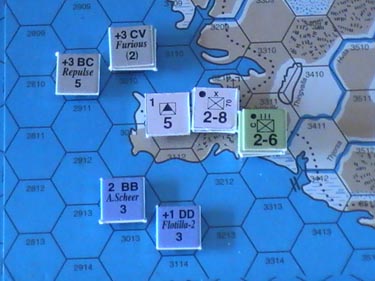 Reykjavik garrison under attack from German 2-6 strength infantry regiments, with heavy naval support | 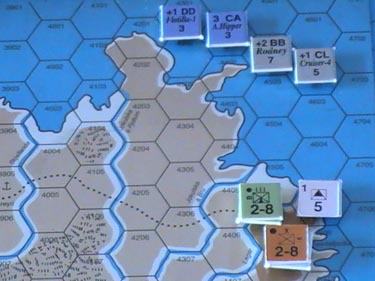 Seydisfjordur, occupied by the Canadians on the east side of Iceland also under attack from Axis forces |